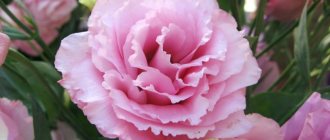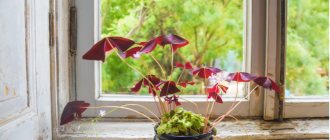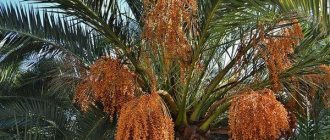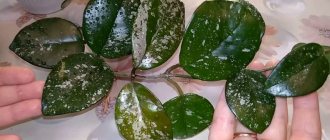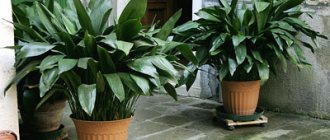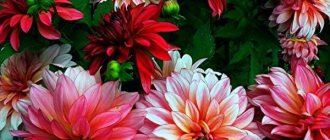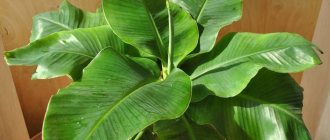Lavender is an evergreen perennial shrub. It attracts people's attention, as its elegance, richness of color and aroma cannot leave anyone indifferent.
Author of the article
Eduard Dmitriev
Florist and lover of indoor and garden plants.
Since ancient times, this plant has been used as a medicine.
Due to its unusual aroma, it is used in the production of perfumes. The French province of Provence is the leader in the cultivation of this plant: 80% of lavender is grown in picturesque French places.
Having managed to adapt lavender to overcome cold climates, this representative of the plant world has become the most recognizable decoration of gardens.
Description of lavender
The medicinal shrub belongs to the Lamiaceae family. The natural habitat is the territories of southern Europe, the Mediterranean, northeast Africa, India, Arabian lands and the mountainous regions of the Caucasus.
The plant has a taproot, woody and developed root system. The stems are straight, the leaves are narrowed, with smooth or jagged edges. Peduncles rise above the main part of the plant. Collected from six to ten flowers. The inflorescence is a spike. The flowers themselves are painted white or purple. The color of the flower varies depending on the species, of which there are quite a lot. When the lavender flowering comes to an end, you can observe the formation of dry seeds.
Lavender blossoms
To achieve bright and rich flowering of lavender, certain conditions must be observed. The flowering itself begins from the first days of summer until autumn. Since there are many varieties, you can enjoy the flowering of this plant in gardens from spring to autumn. Plants that are planted in groups produce a very great effect. During the flowering period, they resemble a very large, beautiful and fluffy carpet.
Perennial varieties
Lavender angustifolia (Lavandula angustifolia)
There are several dozen plant species. Each variety has its own characteristic features. The most popular types of lavender:
- mountain;
- variegated;
- dwarf;
- decorative;
- French;
- narrow-leaved.
Mountain
This is wild lavender. It grows mainly in mountainous areas - in meadows adjacent to mountainous terrain. Unpretentious, but loves warmth and sunny open spaces. The mountain lavender plant has chosen the territory of the Crimean Peninsula. Bushes 50-80 cm high have erect stems.
Mountain lavender
The color of the petals is lilac, bluish-blue. The meadow shrub has flowers collected in inflorescences of 8 pieces in the form of apical spikelets.
Variegated
Another name is variegated. The plant has an unusual color of the petals. The main color is light green. There are beige stripes, mainly along the edges of the foliage.
Variegated species
The species prefers to grow in areas where it is summer all year round.
Dwarf
The dwarf species is a subshrub. Its height does not exceed 14-35 cm. A large number of different varieties have been bred based on this species. For example, there is a white variety, Nana Alba, and a variety, Little Lottie, whose inflorescences have a pleasant light pink color. Among the dwarfs, the Manstead variety stands out. It can only bloom with cornflower blue flowers with a purple tint.
Dwarf representatives of lavender
Important! It is the dwarf variety of lavender that is found in European homes, as it can grow comfortably in tubs and pots.
Decorative
Decorative lavender is a type of plant that feels great next to humans. It decorates areas, but only in warm countries or in apartment conditions. Does not tolerate low temperatures. It is added to dishes and tea.
Decorative bushes
It has a special persistent aroma. A decorative species is jagged lavender.
French
This species is also afraid of the cold. Cultivated in the south. Has wide leaf blades. Because of this, it is called broadleaf.
French version
Inflorescences can be of different colors:
- white;
- lilac;
- deep purple;
- dove-blue.
Narrow-leaved
Another name is English. This is a frost-resistant species. Most often it can be found in central Russia, in the Moscow region, and the Black Earth Region.
Narrow-leaved lavender
Additional Information. Snowy winter is not scary for the narrow-leaved beauty. Under snow cover, lavender survives winters with frosts of 25...30 degrees.
Properties of lavender
Lavender is rich in tannins, aromatic lactones, alcohols and acids. In addition to what is listed, it contains a lot of useful and interesting things. Many of its components, and especially the resulting essential oil, are used in the treatment of many diseases.
Uses of lavender
In folk medicine, dried and fresh lavender is used for problems with the central nervous system and stressful situations, with the gastrointestinal tract, with poor digestion and ailments of the female reproductive system and respiratory organs. To treat such diseases, decoctions and infusions based on lavender are prescribed.
Lotions and essential oils are prescribed for insect bites and skin problems. Such lavender-based products improve the condition of hair. In addition, it is used in massage medicine. Aromatherapy is also an area in which lavender is indispensable.
- Lavender-based tea is an excellent remedy for insomnia and nervous exhaustion. Relieves attacks of nausea and pain during menstruation. The recipe for making tea is simple: throw 2 or 3 tablespoons of dried flowers into a glass of boiling water.
- Leave for about 15 minutes. But you shouldn’t abuse it: 2-3 cups a day and no more! Otherwise, stomach upsets and allergic manifestations may occur.
This plant is also used in cooking! In addition to tea, it is added to various dishes to give a unique taste and aroma.
Lavender essential oil
Due to its unique medicinal properties, essential oil is in great demand in various industries. It is obtained mainly from flowers. The oil content in them reaches 0.8%. The color is almost colorless, but with a subtle yellowish tint. Included in many cosmetic products. Used to strengthen hair and nourish the head, removes dandruff.
The essential oil is not an allergen, but its heavy aroma may not be suitable for some people. If discomfort or difficulty breathing occurs, use should be discontinued. It is not recommended to use the oil for pregnant women, breastfeeding women, or hypertensive patients. The main reason for this ban is the oil’s ability to change hormonal levels and blood pressure.
Lavender care and planting
Without human intervention, the lavender bush grows and develops on its own. However, in this case, it is better not to think about the attractive appearance and beautiful flowering at all. He definitely won't be there. Experienced gardeners and flower growers recommend caring for the plant to ensure the attractiveness of the lavender bush, to achieve its spherical shape and lush flowering.
- The first thing to do is to fluff up the soil under the stem for better oxygen supply and pull out the weeds. Such simple manipulations will allow you to achieve a presentable appearance and long flowering.
- The condition of the soil will help determine when to water. If it is dry, then you definitely need to increase the watering of the lavender. It's important not to overdo it here.
Planting should be done in places where there is enough light and warmth. Lavender, however, can grow in the shade, but if there is insufficient lighting, its decorative effect will suffer.
To improve the condition of the soil, compost or nutrient mixtures are added to it. It is best to place them under the stem, but so that the soil above the roots is not laid, otherwise this may cause them to rot.
Before wintering, the bush is pruned. There should be 10-15 centimeters left at the base. Gardeners advise growing lavender in large pots, which makes it easier to bring it indoors in late autumn and makes care much easier. Also, timely pruning will help improve growth and provide the desired decorative appearance.
Top dressing
To feed lavender, combined mineral fertilizers or nitrogen-based fertilizers are used. Fertilizer is best used before flowering. Under no circumstances should you re-fertilize in the summer, because with such improved plant growth, it will not be able to properly prepare for autumn and cold weather.
Trimming
To achieve an attractive appearance, pruning is required. If you let the development of lavender take its course, you can end up with a monster with a tall stem, bare at the base, and sparse faded leaves.
When young plants (about 20 centimeters) are planted in April, it is advised to trim the randomly spread shoots to improve subsequent growth. After this, until next spring, you need to leave the lavender alone. When April comes again, you need to remove last year's dried inflorescences.
It is very important not to cut off too much when pruning. Many people remove flower stalks in the fall. True, spring is better for this. Preserved inflorescences, even if dry, will help lavender survive the cold period.
As soon as the flowering period has passed, do not prune the bush! It will have shoots. They are still very weak and may not survive the approaching cold.
The ancestors of varieties
Officinalis and broadleaf lavender are grown as ornamental plants. It was these species that gave birth to many cultivated varieties.
- Broadleaf or French lavender. The fragrant evergreen subshrub reaches a height of slightly more than a meter. The plant has a wonderful smell, although the aroma, compared to angustifolia lavender, is not as refined. Beautiful spike-shaped inflorescences reach a length of about ten centimeters. French lavender flowers are colored in a variety of colors: from white and blue to dark lilac. Pink flowers are very unusual. The plant blooms earlier than all other representatives of the genus: from April to June. If the year is favorable, a second flowering occurs with the beginning of autumn. This variety is not afraid of frosts down to minus sixteen degrees. But during harsh winters, shelter is required.
- Narrow-leaved lavender or officinalis. It is best known in our country as an ornamental plant. Russian flower growers know well what angustifolia lavender looks like. This is a strongly branched subshrub. When it grows, it turns into a ball up to one meter in diameter. Narrow long gray-green leaves reach a length of six centimeters. The exquisite subtle aroma is considered the most pleasant. Fragrant flowers bloom from early July to September. This is the most cold-resistant species, withstanding twenty-degree frosts. But it also needs shelter in snowless or especially cold winters.
Pests and diseases
Lavender is a very strong plant. However, it still has pests and diseases.
The most common disease of lavender is gray mold. Gray-brown spots appear on the stem of a diseased plant and rise higher. The leaves fade and wither. Flowers and fruits are also subject to detrimental effects.
If the infection is severe, the lavender may die. The main cause of rot is mainly poor maintenance. Excessive watering negatively affects the life of lavender. Water stagnates, thereby causing rot. In this case, you need to reduce watering.
If the plant is already sick, then you need to cut off the infected parts and burn them away from everyone else. After this, you can treat the lavender with a 1% Bordeaux mixture. As a last resort, you can use a fungicide.
There are two main pests: the pennies and the rainbow beetles. The pennitsa is a hemipteran insect from the cicada family. It eats leaves by gnawing holes. The pennix leaves its offspring on the trunks, attaching them with easily washed off water.
The stag beetle also likes to profit from the leaves of the bush. Damages the teeth on the edges of the leaves. Both insects are removed by hand because chemicals can harm the plant.
Why doesn't it bloom?
It may happen that lavender does not bloom at the right time, the reasons may be the following:
- the plant froze during the winter - the root system was damaged and weakened;
- in the spring they did the wrong pruning - they cut the branches too short, affecting the buds, or, on the contrary, they cut off a small number of branches, which is why sunlight does not reach most of the dense bush;
- the plant had little light or it constantly experienced an excess of moisture (in the lowlands) - the planting site was chosen incorrectly;
- the soil composition is acidified, not suitable for crops;
- fertilizing and fertilizing were not applied on time;
- the presence of diseases, pests or unweeded weeds.
Irregular watering can also negatively affect the flowering of lavender bushes, although this plant tolerates drought well.
Planting and propagating lavender
There are several options for propagating lavender bushes. Seeds must be kept in a humid environment with low air temperatures for three weeks. In general, growing lavender by seed is a very complex and time-consuming process, so it is rarely used.
When purchasing, you should look for young lavender bushes that are adapted to the given environmental conditions. Gardening experts suggest planting lavender in the spring, as soon as the night frosts stop.
Planting can also be done in the fall. But the autumn period is suitable only for the southern regions and with the condition that there are at least two months left before the cold weather. Before planting, the lavender bush should be immersed in cold water for an hour and a half.
Lavender likes to grow on hills, so beds for it should be arranged there. If these are not observed, then you need to make the beds high - around forty centimeters.
To improve further growth, the top of the lavender bush is trimmed. Roots and stems that branch during growth must be removed. Seedlings are planted in depressions from 20 to 30 centimeters.
The gap between two lavender specimens is equal to the height of an adult bush. Lavender seeds have the ability to germinate for a long time. But this is only possible if they are stored correctly. Once the seeds are collected, they are placed in a secure, dry container. When autumn comes, they can be planted in open ground without additional preparation.
Features of cultivation
If possible, seeds are sown very early - at the end of February or in the first ten days of March. They are planted shallowly - only 0.3 cm. They will begin to germinate when the temperature steadily reaches fifteen degrees.
During the first months of life of small bushes, watering is carefully regulated: it should be uniform and plentiful. But under no circumstances should you allow water to stagnate - the plants will get wet. These are inhabitants of rather dry places. When the lavender gets stronger, they begin to water less and less often. To ensure that water quickly leaves the root zone, it is enough to provide the plantings with drainage from bark or expanded clay. Air-permeable soil should not be rich black soil - the plant is unpretentious and grows well in poor soil.
Roots need air to flow into the soil. Therefore, you cannot mulch lavender. And even if the bushes had to be protected from the cold for the winter, immediately open them with the arrival of spring: the base of the plant should not be wet. Damping off begins immediately.
These requirements are dictated by the conditions of lavender’s natural habitat. If you take into account such agrotechnical subtleties, then there will be no problems with growing this crop.
Lavender in open ground
- The planting area must have certain conditions. Well-lit, protected from the wind and without unnecessary obstacles - these are the qualities the territory should have. Shaded areas are not desirable, because lush and rich flowering will not be achieved there.
- To ensure that lavender is protected from freezing, it is recommended to plant it not in the ground, but in large containers. As soon as the cold weather arrives, you can bring them indoors.
- It is extremely dangerous to over-wet the soil. Stagnation of liquid can trigger rotting processes that can kill the plant.
- To use lavender for landscape decoration, it must be pruned. Without pruning, the bush will take on an indeterminate shape.
- It will not be possible to see blooming lavender in the coming months. The appearance of flowers can be expected only next year, but for certain specimens it will take longer.
- Seeds for seedlings are planted in late winter - early spring. To do this, take small containers. Seeds are placed in miniature holes. There may be several holes, with a distance of 2-3 centimeters between them. The containers are covered with a transparent lid, the seeds are watered and additional lighting is provided. Ventilation is required. At temperatures around twenty degrees Celsius, seedlings can be seen in one and a half to two weeks. Only after germination it is necessary to increase the frequency of ventilation. Sprouted seedlings are distributed into separate containers. There should be five centimeters between them.
- Young shoots are perfectly transplantable. For this reason, the end of spring marks their landing in the ground.
Growing lavender at home
At home, lavender is usually planted in a medium-sized pot (about 30 centimeters). The bottom of the container should have holes through which excess liquid will escape.
It is also worth making a drainage layer. Expanded clay, small stones and fragments of bricks or nut shells are ideal for it. In no case should it block the holes for draining excess water. The soil itself should be a peat-sand mixture with the addition of eggshells.
At home, lavender must be properly watered. The soil should always have a high percentage of moisture, but the liquid should not be allowed to stagnate for a long period. It is also necessary to moisten the green areas of the plant. Lavender likes this approach. Overwatering can kill it.
The plant loves sufficient humidity, plenty of heat and light. The plant feels best on the south side of the windows. If there is less light, you can use lamps so that the daylight hours are 10 hours. During wintering, you need to move the plant to a cooler place and reduce watering.
If the flower continues to grow, then in the spring the regrown shoots must be cut off. With the onset of warm weather, it is necessary to ensure that you stay outside. Every day you need to increase your stay time. With this, the plant will come closer to natural conditions and strengthen its body.
Planting lavender using seeds
For successful planting of seeds, they must be stratified. They need to be placed in a container with wet sand and closed. Then refrigerate. So store it at a temperature of 5 degrees for no more than two months.
In the second autumn month, planting occurs in open ground with sufficient humidity. In winter, the lavender bed should be covered with snow. This is how seeds are stratified under natural conditions. Shoots will appear only after the night frosts have stopped: in May or later.
Treated seeds are also necessary for planting in spring. If, after staying in a closed container with peat soil and regular watering, no shoots appear after three weeks, then the seeds are placed in the refrigerator for a month.
This approach provides the seeds with additional stratification. In May, when the night temperature is at least 6 degrees, the seeds are sown in the ground, two centimeters apart.
Propagation of lavender by cuttings
Propagating lavender from cuttings is very simple and does not require much effort. You need to take the woody shoots, divide them into ten-centimeter pieces and plant them in moist soil.
After this, they need to be covered with transparent material and ensure constant watering. The air temperature should be around 15-20 degrees Celsius, a sufficient level of lighting and a lot of heat - by observing such factors, everything will go fine. When warmer weather arrives, they are opened. The shoots quickly take root and begin to grow.
Layering is a quick way of propagation. They take no more than three branches from the bush, press them to the ground and bury them in holes five centimeters deep. They are fixed with staples and covered with soil. Then the branches take root, and the resulting bush, using pruning, is separated and planted in the fall.
The essence of the division method is this: after pruning, the bush is covered with earth. With the onset of summer, it grows well and produces many shoots, which then take root. In the fall, the bush is dug up and divided into parts. Then the separated shoots are planted in the ground and new lavender bushes are obtained.
Picking stage
When the first three true leaves develop on the seedlings, the roots in the planting container grow so large that they have no room to develop further. This means it's time for a transplant. And the substrate is no longer suitable for grown plants. Lavender lives in alkaline soil.
Larger pots or boxes are filled with fresh soil. In trays, seedlings are planted at a distance of five centimeters from each other. During the first picking, granular fertilizer is used as top dressing. When watering, it will dissolve and gradually be absorbed by the plants.
Lavender is replanted together with a lump of old substrate, without shaking it off the roots. In the new container, the seedling is well fixed, compacting the soil around it, and the plant is watered. Lavender is pictured in a pot below.
The second picking is carried out when the plants reach about seven centimeters in height. Small bushes will gain such growth in a month, or even three. During this time, the seedlings are gradually adapted to the open air. Pots and boxes of lavender are taken out into the garden, at first for just a few hours. After a week, the plants get used to living in nature. By the way, lavender tolerates urban conditions quite calmly.
Lavender in winter
Of the many types of lavender, a small number of them are frost-resistant specimens. The maximum limit for them is minus twenty degrees Celsius. But it is best to cover lavender before the onset of cold weather.
Preparations for wintering begin at the end of the autumn period. Trimmed bushes are covered with tree branches; most often pine needles are used for this task. It is not recommended to cover bushes with leaves, as they can rot and rot.
Interior decoration
Having a garden is not the most important condition for enjoying this plant. A couple of bunches of lavender or a miniature pot of this plant is an excellent choice for the interior. Rich colors and intoxicating aroma are the perfect combination to enliven and add variety to your home.
A beautiful flower, Craspedia, will also fit well into your interior.
Lavender is a useful and irreplaceable plant. Use in many areas of life makes it indispensable. And its natural beauty, delicate color and unforgettable aroma make it very memorable and unique.
Preparing for sowing
You need to take care of suitable containers in advance. Choose a wide and deep container. Lavender has a taproot. As it grows, it will simply stop developing in a small space.
If you decide to choose a pot for sowing, then the diameter of such a container should be at least thirty centimeters. The prepared container is washed with detergent.
Another key point is acquiring suitable soil. Lavender prefers loose, breathable soil. This is vital for small seedlings. A store-bought substrate will do, or you can mix sand and peat in a 1:1 ratio. Adding a handful of perlite will help.

